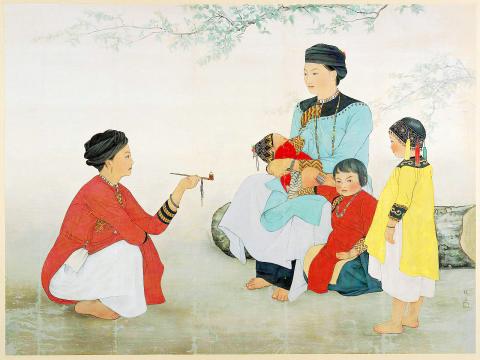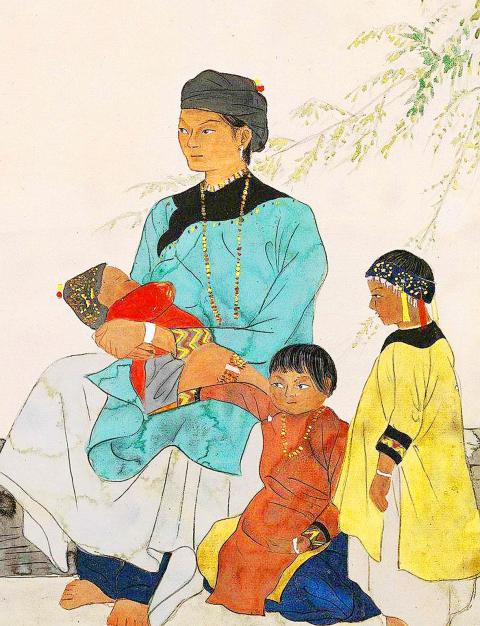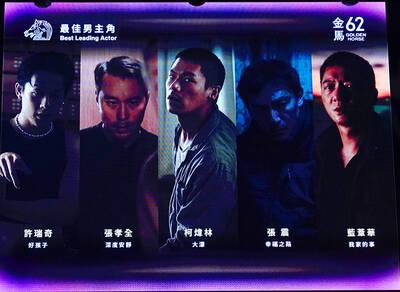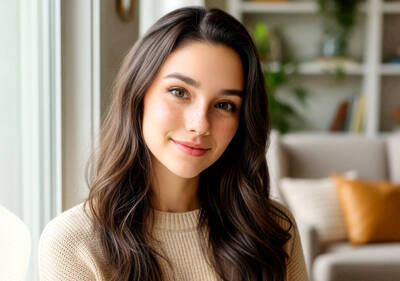In 1934, Chen Chin (1907 - 1998), known as one of the three young Taiwanese selected to exhibit at the Taiwan Art Exhibition (Taiten) during the Japanese colonial period, taught at the Takao (Kaohsiung) Prefecture Heito High School for Girls — present day Pingtung Girls’ Senior High School — becoming the first Taiwanese woman to teach at a Japanese colonial era high school.
Aborigines, quite distinct from people from the local area in their clothing and general appearance, would often come by the school neighborhood, and their clothing and general apparance attracted Chen’s attention. When she was not teaching, she would go into the Paiwan Aboriginal area of Sandimen to paint.
Chen used this subject matter to paint a draft for a large work entitled The Women of Sandimen Area (photo 1). This was completed at Tokyo’s Kanei-ji Temple in 1936, and was selected for inclusion at the New Ministry of Education Art Exhibition.

Photo: Liberty Times
照片:自由時報
Rendered in Chen’s brushwork style — Chen is known for her Japanese-style Nihonga gouache paintings — the woman cradling a baby, the little girls dressed in red and yellow, and the woman squatting and holding a pipe to the left of the composition, are all natural and elegantly poised. With the various scarves, clothes and jewelry denoting different social status, the meticulous rendering and rich colors of the work have distinctly ethnic features.
Interestingly, when one compares the earlier drafts with the final exhibited work, the figures in the draft feature beady eyes and rather haughty postures, as well as darker skin color (photos 2 and 3). Of course, the grand scale, attention to detail and high degree of completeness of the exhibited piece make it the more “beautiful” version, but one cannot help feel that something of the edge of the figures as originally captured by the artist has been smoothed away, such that they appear more like the non-Aboriginal inhabitants of Taiwan at the time, albeit in Aboriginal clothes, while the woman smoking holds her pipe in a way one might associate more with a French woman. These changes were perhaps made to more suit the aesthetic preferences of the Japanese exhibition judges, both in terms of the depiction of the female and of other ethnicities, so that they were exotic without appearing threatening.
The education and exhibition systems of Japanese colonial-period Taiwan were formative influences on modern Taiwanese art. Chen Chin received many awards for her work during her lifetime, and one can imagine that she was fully aware of the rules of that particular game, forging herself a way through the prickly path of gender and ethnic differences.

Photo: Liberty Times
照片:自由時報
(Translated by Paul Cooper)
一九三四年,「台展三少年」之一的陳進(一九○七年~一九九八年)應邀至高雄州立屏東高女(今屏東女中)教書,成為日治時期第一位任教於高級中學的台籍女教師。
學校附近常有原住民來交易,他們的裝束、樣貌與平地人極為不同,深深吸引了陳進的注意,因此在教書之餘,她常去排灣族部落三地門寫生。

Photo: Liberty Times
照片:自由時報
她根據寫生的材料畫成一幅草圖,一九三六年借用日本東京寬永寺的空間完成大幅的作品,名為《三地門社之女》(圖一),入選了日本文部省美展。
在膠彩人物畫名家陳進筆下,抱著嬰孩的女子、紅衣和黃衣小女孩、蹲在左方手持煙斗的女人,有著自然優雅的神態;表示不同身份地位的頭巾、衣服、珠鏈,其精緻的圖樣和豐富的色彩極具民族特色。
耐人尋味的是,比較草圖和參展成圖,草圖中的人物有著更銳利的眼神、更桀驁的神態,以及更深的膚色(圖二、圖三)。當然,參展圖大畫幅的氣勢,及其細緻與完成度讓這幅畫「很美」;但寫生時所捕捉的人物形象那種野性的稜角被磨去了,變得像是平地人,只是穿著原住民裝束,持菸斗的女人則令人聯想起法國仕女的抽煙形象。這樣的變化,或許符合了日本男性評審的期待,無論是對於女性,或是異族,這是不造成威脅的異國情調。
日治時期的教育及展覽比賽機制,形塑了現代台灣美術的面貌,獲獎無數的陳進,想必深諳遊戲規則,在族群與性別的荊棘中闢出一條路。
(台北時報林俐凱)

A: The 62nd Golden Horse Awards ceremony is set for next weekend. So what are the nominees for Best Narrative Feature? B: The nominees are: A Foggy Tale, The Waves Will Carry Us, Left-Handed Girl, Queerpanorama and Mother Bhumi. A: What about the nominees for Best Leading ActorActress? B: Richie Koh, Will Or, Joseph Chang, Chang Chen and Lan Wei-hua are nominated for Best Leading Actor. Caitlin Fang, Rene Liu, Ariel Lin, Alexia Kao and Fan Bingbing are nominated for Best Leading Actress. A: It’s a shame that many of those movies haven’t even been released yet. Meanwhile, some blockbusters won zero nominations this

A: For next weekend’s Golden Horse Awards ceremony, the Lifetime Achievement Award will go to Chen Shu-fang. B: Didn’t Chen win both Best Leading Actress and Best Supporting Actress in 2023? What a talented performer she is. A: But with the debut of the world’s first AI-generated “actress,” human performers may start to worry about their jobs. B: The news says the debut of AI-generated “actress” Tilly Norwood in a recent conference attracted studio executives’ interest. A: With big stars like Robert Redford and Diane Keaton passing away one after another, could human performers gradually be replaced in the future? A: 下週末登場的金馬獎,終身成就獎將頒給陳淑芳! B: 她前年不是同時贏得女主角、女配角獎?真是位好演員。 A: 但隨著全球首位人工智慧(AI)生成「女星」亮相,人類演員或許要開始擔心了。 B:

Have you ever felt a sudden pang of discomfort after handing over cash? That sensation is known as the pain of paying, the emotional sting that __1__ when money leaves your hands. Neuroscientific studies suggest that this pain activates the insula, an area in the brain associated with physical pain and negative emotions. This pain comes about because making a purchase forces people to __2__ the loss of financial resources, making the act of buying feel like a sacrifice. The pain intensifies under certain conditions. The more __3__ people are of the payment—its timing, amount, and method—the stronger the

1. 她把畫掛在書房牆上。 ˇ She hung the picture on her study wall. χ She hanged the picture on her study wall. 註:hanged 是 hang(吊死,絞死)的過去式。hang 作「掛」解時過去式是 hung,過去分詞也是 hung。 2. 他失去平衡,跌倒在地。 ˇ He lost his balance and fell down. χ He lost his balance and felled down. 註:felled 是動詞 fell 的過去式,作「砍倒」解,是及物動詞。這裡作「跌倒」解是 fall,過去式是 fell,過去分詞是 fallen。 3. 我剛才把照相機放在桌上。 ˇ I laid the camera on the table a moment ago. χ I lay the camera on the table a moment ago. 註:從句義可以看出動詞須用過去式「將…放、置」,動詞現在式是 lay,過去式和過去分詞都是 laid:lay, laid, laid;但 lay 也是 lie 的過去式,作「躺」解:lie, lay, lain,是不及物動詞。 注意:兩個形同義不同的 lay,不要用錯。 4. 他去過韓國。 ˇ He has been to Korea. ˇ He visited Korea some time ago. χ He has gone to Korea. 註:He has gone to Korea. 是「他已經到韓國去了」,指目前人已在韓國或在赴韓國的途中。表示「過去曾去過某處」,應用 have/has been,或用動詞的過去式和表示過去時間的副詞來表達。 5.